高中英语>高考【讲语法】17 倒装句、强调句、省略句语法知识点梳理课件(全国通用)(21张ppt)
文档属性
| 名称 | 高中英语>高考【讲语法】17 倒装句、强调句、省略句语法知识点梳理课件(全国通用)(21张ppt) | 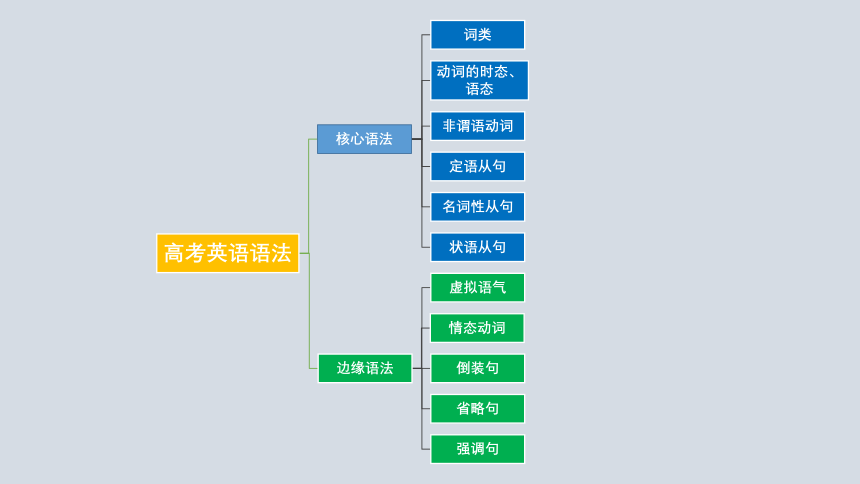 | |
| 格式 | zip | ||
| 文件大小 | 1.8MB | ||
| 资源类型 | 教案 | ||
| 版本资源 | 通用版 | ||
| 科目 | 英语 | ||
| 更新时间 | 2022-11-19 13:10:21 | ||
图片预览

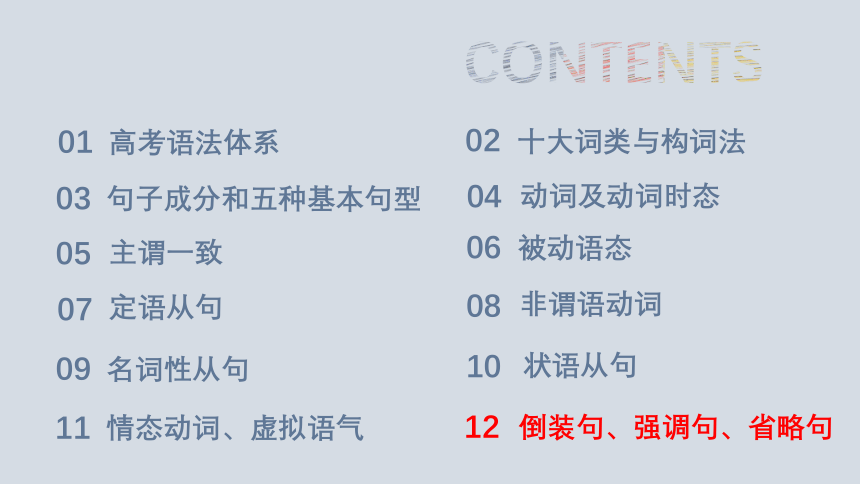
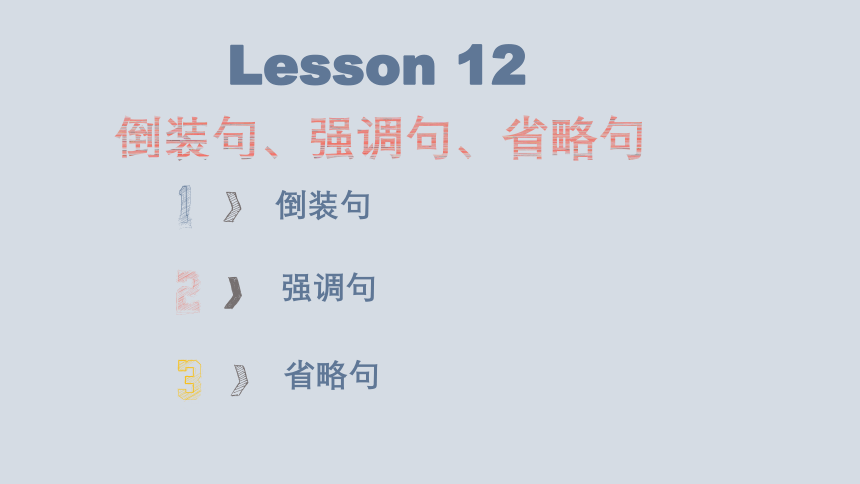
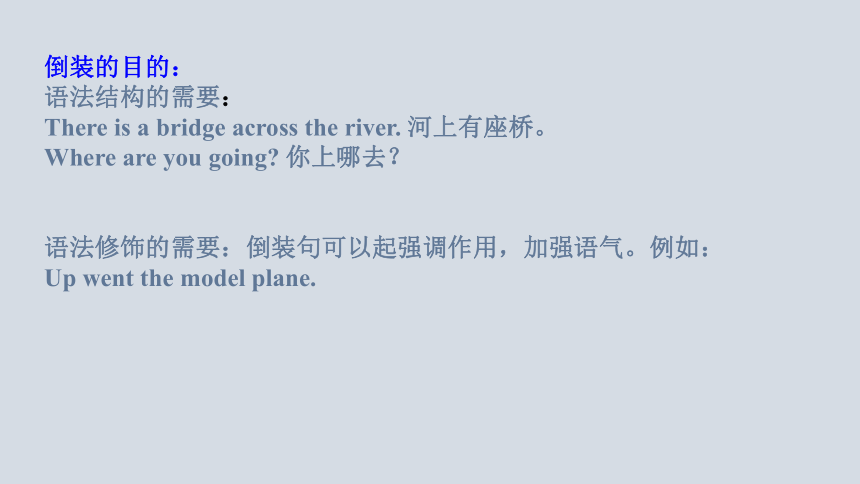


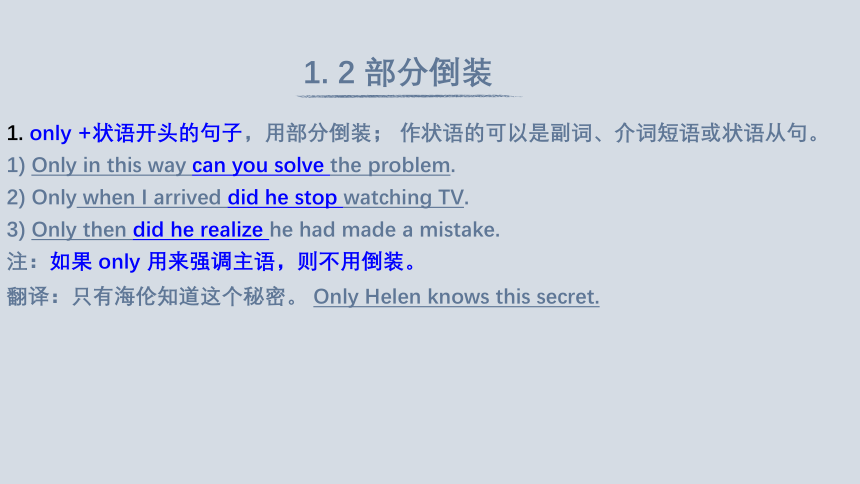
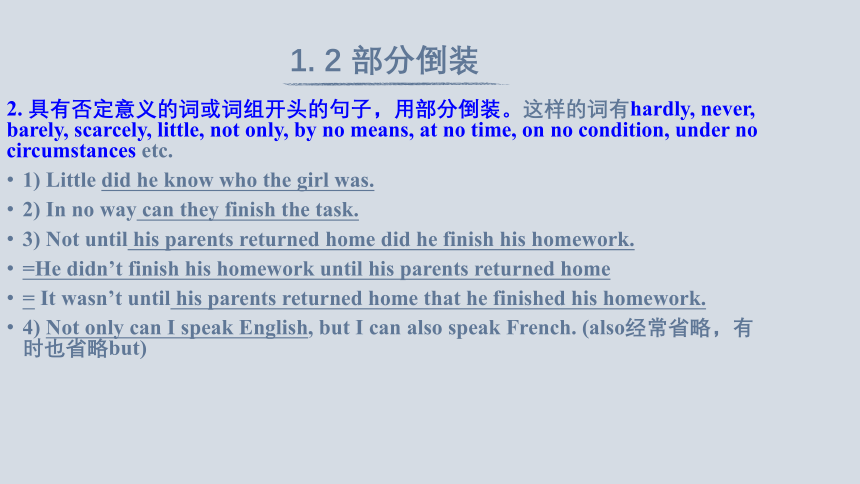
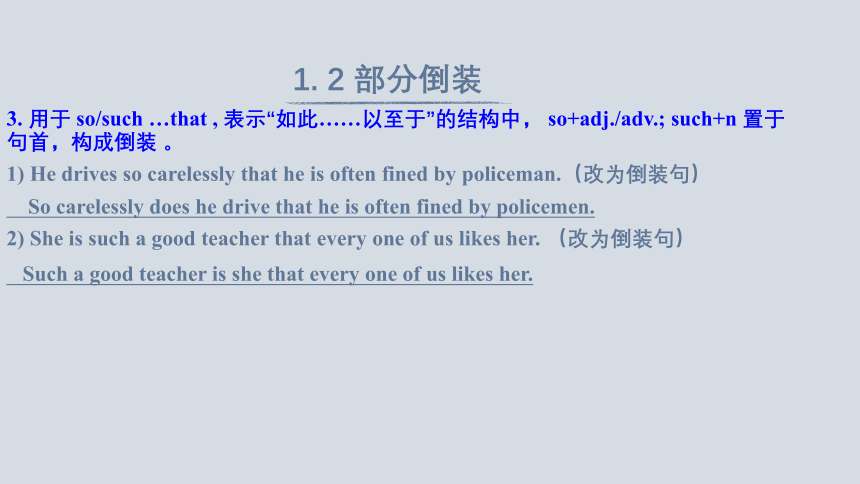
文档简介
(共21张PPT)
CONTENTS
十大词类与构词法
02
动词及动词时态
04
非谓语动词
08
名词性从句
09
情态动词、虚拟语气
11
倒装句、强调句、省略句
12
高考语法体系
01
句子成分和五种基本句型
03
被动语态
06
定语从句
07
状语从句
10
主谓一致
05
倒装句
强调句
省略句
倒装句、强调句、省略句
Lesson 12
倒装的目的:
语法结构的需要:
There is a bridge across the river. 河上有座桥。
Where are you going 你上哪去?
语法修饰的需要:倒装句可以起强调作用,加强语气。例如:
Up went the model plane.
英语倒装句分为两种:
1、整个谓语在主语前的句子,叫完全倒装。
Here comes the car.
2、部分谓语(情态动词、助动词、连系动词)在前,谓语的主体部分仍在主语之后的句子,叫部分倒装句。
Only then did he realize that he was wrong.
(直到)…才
1. 1 倒装句
1. 句首有 here, there, now, then, out, in, up, down, off, away 等表示地点、时间、方位的副词时:
Out rushed a cat.
There goes the bell.
Up went the price.
1. 1 完全倒装
人称代词不倒装:
Here you are.
There he goes.
2. 介词短语表方位放句首
On the ground lay a goat.
(In the) east of Zibo lie many chemical factories.
(谓语通常是be , stand, sit , lie 等动词)
1. only +状语开头的句子,用部分倒装; 作状语的可以是副词、介词短语或状语从句。
1) Only in this way can you solve the problem.
2) Only when I arrived did he stop watching TV.
3) Only then did he realize he had made a mistake.
注:如果 only 用来强调主语,则不用倒装。
翻译:只有海伦知道这个秘密。 Only Helen knows this secret.
1. 2 部分倒装
2. 具有否定意义的词或词组开头的句子,用部分倒装。这样的词有hardly, never, barely, scarcely, little, not only, by no means, at no time, on no condition, under no circumstances etc.
1) Little did he know who the girl was.
2) In no way can they finish the task.
3) Not until his parents returned home did he finish his homework.
=He didn’t finish his homework until his parents returned home
= It wasn’t until his parents returned home that he finished his homework.
4) Not only can I speak English, but I can also speak French. (also经常省略,有时也省略but)
1. 2 部分倒装
3. 用于 so/such …that , 表示“如此……以至于”的结构中, so+adj./adv.; such+n 置于句首,构成倒装 。
1) He drives so carelessly that he is often fined by policeman.(改为倒装句)
So carelessly does he drive that he is often fined by policemen.
2) She is such a good teacher that every one of us likes her. (改为倒装句)
Such a good teacher is she that every one of us likes her.
1. 2 部分倒装
4. as 作“尽管、虽然”解,引导让步状语从句时,引起倒装,需要倒装前置的内容有表语名词去冠词;表语形容词;动词后副词;情态动词后动原。
1) Although I like her much, I will never marry her. (改为由as引导的倒装句)
Much as I like her, I will never marry her.
2) Although he is young, he knows a lot. (改为由as引导的倒装句)
Young as he is, he knows a lot.
3) Although they would try, they might fail again. (改为由as引导的倒装句)
Try as they would, they might fail again.
注: 从句中作表语的单数名词放句首,须省略前面冠词。
Child as he is, he knows a lot. 尽管他是个孩子,他懂得很多。
1. 2 部分倒装
5. 表示前一个人的情况也适合于后一个人。
1) He has been to Beijing. So have I.
2) Li wei can’t answer the question. Neither can I.
基本结构:It + is/was + 被强调成分 + that / who + 其他成分
被强调的成分可以是主语、宾语和状语,但不能是谓语.被强调部分指人, 用who或that;指物,只用that。
e.g. He met an old friend in the park yesterday.
It was he who/that met an old friend in the park yesterday.
It was an old friend that/who he met in the park yesterday.
It was in the park that he met an old friend yesterday.
It was yesterday that he met an old friend in he park.
强调主语
强调宾语
强调地点状语
强调时间状语
2. 1 强调句
一般疑问形式
Is/was +it +强调部分+ that+其余部分
2. 2 强调句形式
He met an old friend in the park yesterday.
It was in the park that he met an old friend yesterday.
Was it in the park that he met an old friend yesterday
Where was it that he met an old friend yesterday
When was it that he met an old friend in the park
特殊疑问形式 特殊疑问词+is / was + it + that / who +其余部分
(1) It was three hours ago _____ he left here.
( 答案: that ,强调句型)
(2) It was three o’clock ______ he left here.
( 答案: when,时间状语从句)
(3) It is three hours _________ he left here.
( 答案: since,时间状语从句)
(4) It wasn’t long ________ he left here.
( 答案: before,时间状语从句)
用that ,before, when, since完成句子
2. 3 强调句
I didn’t wake up until I heard the alarm clock.
= Not until I heard the alarm clock did I wake up.
= It was not until I heard the alarm clock that I woke up.
= I woke up after/when I heard the alarm clock.
2. 4 until 强调句
when引导的为时间状语从句“It be + 时间 + when ...”句型,表“某事发生时正是……时候”。
It was midnight when he got home yesterday.
昨天他到家的时候已是半夜。(when引导的为时间状语从句,it为代词,指时间.)
2.5 时间状语从句when
比较:
It was at midnight that he got home yesterday.
他昨天是半夜到家的。
(本句为强调句,强调at midnight,去掉it was及that 句子结构仍完整.)
since+持续性动词过去式(从动作结束时算起)
since+瞬间动词过去式(从该动作发生时算起)
It is two years since he smoked.他戒烟已有两年了。
It is two years since he joined the army. 他参军两年了。
常用句式:
It is/has been+一段时间+since...(从句用一般过去时)
It has been three years since I began to learn English.
2.6 时间状语从句since
since一般用于“现在完成时”或“一般现在时”;since表示“自从”时,通常与现在完成时连用;主句表示“多长时间”时,动词可用一般现在时(也可用现在完成时)。
before引导时间状语从句表示“在…之前”, 从句中常用如下句型:
It will be long before...(得过好久才……)
It will not be long before...(不久就……)
It was long before...(过了好久才……)
It was not long before...(过了不久就……)
It will be half a year before I come back.
It won't be long before you regret for what you've done.
It wasn't be long before they came back.
It was long before they met again.
2.7 时间状语从句before
一、状语从句的省略
省略句
考点3
用法 例句
1.表示条件、时间、地点、方式或让步等的状语从句的谓语含有be动词,且从句的主语又和主句中的主语一致,或者主语是it时,常把从句中的主语连同be动词一起省略。 If (it is) necessary,I'll go with you.
如果有必要的话,我和你一起去。
Be careful when(you are)crossing the street.
过马路时要当心。
用法 例句
2.用so或not代替上文内容,此时可用“if+so/not”省略句式 Get up early tomorrow. If not(=If you don't get up early) , you will miss the first bus.
明天要早起。如果不,你就赶不上首班公共汽车。
二、动词不定式的省略
用法 例句
1.在动词不定式结构中,为了避免重复,常常省略不定式结构中的动词原形,只保留to。否定式的省略用not to。 —Would you like to go with us
你愿意和我们一起去吗?
—I'm glad to,but I'm too busy.
我很乐意去,但是我太忙了。
The boy wanted to smoke but was told by the teacher not to.
那个男孩想抽烟,但是老师不让那样做。
用法 例句
2.感官动词和使役动词后面作宾补的不定式要省略to;但被动语态中的to不可省略。 I saw him enter the classroom just now.
=He was seen to enter the classroom just now.
我刚才看见他走进了教室。
3.介词but,except前有实义动词do的具体形式时,后面的不定式不带to。 All he could do was nothing but wait and see.
他所能做的只有等着瞧。
CONTENTS
十大词类与构词法
02
动词及动词时态
04
非谓语动词
08
名词性从句
09
情态动词、虚拟语气
11
倒装句、强调句、省略句
12
高考语法体系
01
句子成分和五种基本句型
03
被动语态
06
定语从句
07
状语从句
10
主谓一致
05
倒装句
强调句
省略句
倒装句、强调句、省略句
Lesson 12
倒装的目的:
语法结构的需要:
There is a bridge across the river. 河上有座桥。
Where are you going 你上哪去?
语法修饰的需要:倒装句可以起强调作用,加强语气。例如:
Up went the model plane.
英语倒装句分为两种:
1、整个谓语在主语前的句子,叫完全倒装。
Here comes the car.
2、部分谓语(情态动词、助动词、连系动词)在前,谓语的主体部分仍在主语之后的句子,叫部分倒装句。
Only then did he realize that he was wrong.
(直到)…才
1. 1 倒装句
1. 句首有 here, there, now, then, out, in, up, down, off, away 等表示地点、时间、方位的副词时:
Out rushed a cat.
There goes the bell.
Up went the price.
1. 1 完全倒装
人称代词不倒装:
Here you are.
There he goes.
2. 介词短语表方位放句首
On the ground lay a goat.
(In the) east of Zibo lie many chemical factories.
(谓语通常是be , stand, sit , lie 等动词)
1. only +状语开头的句子,用部分倒装; 作状语的可以是副词、介词短语或状语从句。
1) Only in this way can you solve the problem.
2) Only when I arrived did he stop watching TV.
3) Only then did he realize he had made a mistake.
注:如果 only 用来强调主语,则不用倒装。
翻译:只有海伦知道这个秘密。 Only Helen knows this secret.
1. 2 部分倒装
2. 具有否定意义的词或词组开头的句子,用部分倒装。这样的词有hardly, never, barely, scarcely, little, not only, by no means, at no time, on no condition, under no circumstances etc.
1) Little did he know who the girl was.
2) In no way can they finish the task.
3) Not until his parents returned home did he finish his homework.
=He didn’t finish his homework until his parents returned home
= It wasn’t until his parents returned home that he finished his homework.
4) Not only can I speak English, but I can also speak French. (also经常省略,有时也省略but)
1. 2 部分倒装
3. 用于 so/such …that , 表示“如此……以至于”的结构中, so+adj./adv.; such+n 置于句首,构成倒装 。
1) He drives so carelessly that he is often fined by policeman.(改为倒装句)
So carelessly does he drive that he is often fined by policemen.
2) She is such a good teacher that every one of us likes her. (改为倒装句)
Such a good teacher is she that every one of us likes her.
1. 2 部分倒装
4. as 作“尽管、虽然”解,引导让步状语从句时,引起倒装,需要倒装前置的内容有表语名词去冠词;表语形容词;动词后副词;情态动词后动原。
1) Although I like her much, I will never marry her. (改为由as引导的倒装句)
Much as I like her, I will never marry her.
2) Although he is young, he knows a lot. (改为由as引导的倒装句)
Young as he is, he knows a lot.
3) Although they would try, they might fail again. (改为由as引导的倒装句)
Try as they would, they might fail again.
注: 从句中作表语的单数名词放句首,须省略前面冠词。
Child as he is, he knows a lot. 尽管他是个孩子,他懂得很多。
1. 2 部分倒装
5. 表示前一个人的情况也适合于后一个人。
1) He has been to Beijing. So have I.
2) Li wei can’t answer the question. Neither can I.
基本结构:It + is/was + 被强调成分 + that / who + 其他成分
被强调的成分可以是主语、宾语和状语,但不能是谓语.被强调部分指人, 用who或that;指物,只用that。
e.g. He met an old friend in the park yesterday.
It was he who/that met an old friend in the park yesterday.
It was an old friend that/who he met in the park yesterday.
It was in the park that he met an old friend yesterday.
It was yesterday that he met an old friend in he park.
强调主语
强调宾语
强调地点状语
强调时间状语
2. 1 强调句
一般疑问形式
Is/was +it +强调部分+ that+其余部分
2. 2 强调句形式
He met an old friend in the park yesterday.
It was in the park that he met an old friend yesterday.
Was it in the park that he met an old friend yesterday
Where was it that he met an old friend yesterday
When was it that he met an old friend in the park
特殊疑问形式 特殊疑问词+is / was + it + that / who +其余部分
(1) It was three hours ago _____ he left here.
( 答案: that ,强调句型)
(2) It was three o’clock ______ he left here.
( 答案: when,时间状语从句)
(3) It is three hours _________ he left here.
( 答案: since,时间状语从句)
(4) It wasn’t long ________ he left here.
( 答案: before,时间状语从句)
用that ,before, when, since完成句子
2. 3 强调句
I didn’t wake up until I heard the alarm clock.
= Not until I heard the alarm clock did I wake up.
= It was not until I heard the alarm clock that I woke up.
= I woke up after/when I heard the alarm clock.
2. 4 until 强调句
when引导的为时间状语从句“It be + 时间 + when ...”句型,表“某事发生时正是……时候”。
It was midnight when he got home yesterday.
昨天他到家的时候已是半夜。(when引导的为时间状语从句,it为代词,指时间.)
2.5 时间状语从句when
比较:
It was at midnight that he got home yesterday.
他昨天是半夜到家的。
(本句为强调句,强调at midnight,去掉it was及that 句子结构仍完整.)
since+持续性动词过去式(从动作结束时算起)
since+瞬间动词过去式(从该动作发生时算起)
It is two years since he smoked.他戒烟已有两年了。
It is two years since he joined the army. 他参军两年了。
常用句式:
It is/has been+一段时间+since...(从句用一般过去时)
It has been three years since I began to learn English.
2.6 时间状语从句since
since一般用于“现在完成时”或“一般现在时”;since表示“自从”时,通常与现在完成时连用;主句表示“多长时间”时,动词可用一般现在时(也可用现在完成时)。
before引导时间状语从句表示“在…之前”, 从句中常用如下句型:
It will be long before...(得过好久才……)
It will not be long before...(不久就……)
It was long before...(过了好久才……)
It was not long before...(过了不久就……)
It will be half a year before I come back.
It won't be long before you regret for what you've done.
It wasn't be long before they came back.
It was long before they met again.
2.7 时间状语从句before
一、状语从句的省略
省略句
考点3
用法 例句
1.表示条件、时间、地点、方式或让步等的状语从句的谓语含有be动词,且从句的主语又和主句中的主语一致,或者主语是it时,常把从句中的主语连同be动词一起省略。 If (it is) necessary,I'll go with you.
如果有必要的话,我和你一起去。
Be careful when(you are)crossing the street.
过马路时要当心。
用法 例句
2.用so或not代替上文内容,此时可用“if+so/not”省略句式 Get up early tomorrow. If not(=If you don't get up early) , you will miss the first bus.
明天要早起。如果不,你就赶不上首班公共汽车。
二、动词不定式的省略
用法 例句
1.在动词不定式结构中,为了避免重复,常常省略不定式结构中的动词原形,只保留to。否定式的省略用not to。 —Would you like to go with us
你愿意和我们一起去吗?
—I'm glad to,but I'm too busy.
我很乐意去,但是我太忙了。
The boy wanted to smoke but was told by the teacher not to.
那个男孩想抽烟,但是老师不让那样做。
用法 例句
2.感官动词和使役动词后面作宾补的不定式要省略to;但被动语态中的to不可省略。 I saw him enter the classroom just now.
=He was seen to enter the classroom just now.
我刚才看见他走进了教室。
3.介词but,except前有实义动词do的具体形式时,后面的不定式不带to。 All he could do was nothing but wait and see.
他所能做的只有等着瞧。
